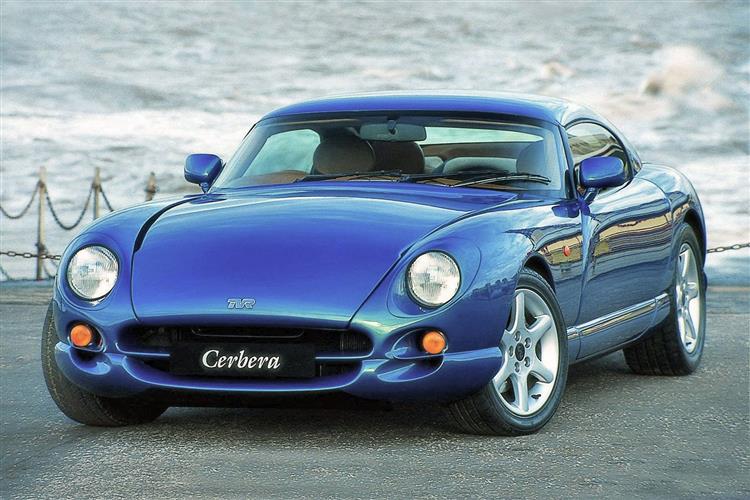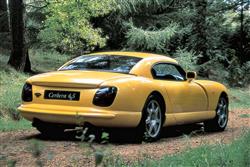HAIR OF THE DOG (some text hidden) --NONE--
BY ANDY ENRIGHT
Introductionword count: 123
The Cerbera, more than any other TVR before it, cemented the Blackpool company's place in the big league of performance car manufacturers. Here was a proper 2+2 sports coupe with crushing power, sleek good looks and an affordable price tag. What's more, it also offered a range of engines developed entirely in-house. Few believed that TVR had either the technical acumen or financial muscle to manage this, but with three different TVR-designed engines now residing under the elegant bonnets of the Cerbera range, some quite considerable amounts of humble pie have been eaten. One issue that has dogged the Cerbera has been reliability. Some high-profile cars have spectacularly failed, so what can the general public expect from a used model? Find out here.
Modelsword count: 9
Models Covered: (2 dr coupe 4.0, 4.2, 4.5 petrol)
Historyword count: 254
The Cerbera was first displayed at the 1993 London Motor Show. Named after Cerberus, the mythical three-headed dog guarding the gates of Hades, the show car was anything but a hellish dog's dinner. Based on a lengthened Chimaera platform, the Cerbera stunned all who saw it. With its wild interior and long doors with no handles to break up the curvaceous lines, advance orders were taken from day one. It wasn't until the start of 1996 that the first customer cars were delivered. Powered by the TVR AJP8 4.2-litre V8 engine, the Cerbera 4.2 hit the covers of every motoring magazine in the country with its incredible performance figures. Unfortunately the press demonstrators suffered some problems, one locking its occupants in, another's rear window being sucked out and a third having its timing chain disintegrate. Whilst working to fix many of the problems that owners were experiencing, TVR announced the Cerbera 4.5 in 1997. With even more power than the 4.2-litre car (420 vs 360bhp) it was more muscular in the upper reaches of the rev band but slightly less responsive lower down, to the disappointment of some. January 1999 saw the launch of the Cerbera Speed Six, using a four-litre straight-six cylinder engine, again of TVR's own design. A remarkably lightweight and compact unit, the Speed Six developed 350bhp and even more torque than the 4.2-litre V8. The Speed Six is now the most popular engine choice in the entire TVR range, although most used Cerberas will be fitted with the 4.2-litre V8.
What You Getword count: 331
What's it like to live with a Cerbera? Well, it's certainly never dull. The interior, with its underslung instruments and wild swooping dashboard never fails to delight, and gives rise to certain Cerbera rituals. Pressing the red button under the steering wheel cuts the ignition. The engine stops instantly, like a racing car. That steering wheel holds push button controls for lights, washers wipers and horn. Once you've worked out which switch does what, it's surprisingly intuitive. The back seats are best reserved as additional luggage space, unless you plan to make a habit of transporting people who have no heads or legs. There is however, a surprisingly generous amount of stowage space around the fascia. Before you take a test drive in the Cerbera, it'll boost your credibility enormously if you know the procedure for getting out of one. There's no internal door handle, you see. The Griffith used a little lever on the transmission tunnel and the Chimaera had a rotating aluminium pastille next to the gearlever, but the Cerbera has something different. On the door's side pocket is a tiny button which you'll need to press to make the door spring open. Likewise to get in you must deactivate the alarm and press a button on the underside of the door mirror. To start the Cerbera press a black button below the fuel gauge. Hold it in, wait for the electronic diagnostics to do their stuff and then listen to the engine spring into life. Both the AJP8 engines and the Speed Six respond to the throttle in an alarmingly direct way. It feels as if the car's engine is hardwired to your foot. There's no flab or mush in the throttle pedal. Press it and the revs rise, take your foot off and they die back. Instantly. People buy Cerberas for the soundtrack and the car doesn't disappoint. It's a magnificently hard-edged sound, quite different to the burbling Rover V8 cars of the past, but equally evocative.
To see the full road test text contact us on 0330 0020 227
Pictures (high res disabled)


|
Scoring (subset of scores)
Category: Sporting Cars
| Performance | |
| Handling | |
| Comfort | |
| Space | |
| Styling, Build, Value, Equipment, Depreciation, Handling, Insurance and Total scores are available with our full data feed. | |



